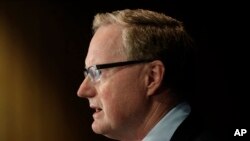The coronavirus shutdown and the summer bushfires have ended Australia's run of 29 years of uninterrupted economic growth. Gross domestic product, or national income, for the March quarter fell, dragging Australia into recession for the first time since the early 1990s.
George H. W. Bush was the U.S. president when Australia last went into recession in 1991. That proud record of almost 30 years of uninterrupted growth has come to a shuddering halt.
In a recession an economy shrinks, or goes into reverse.
Latest figures show the Australian economy was in trouble before the COVID-19 outbreak after a devastating bushfire season, a slowdown in tourism and weak domestic demand. The pandemic has only added to the decline.
Lockdown restrictions to stem the spread of the coronavirus saw thousands of businesses forced to close, including gyms, cafes, theaters and shops.
Unemployment is expected to double to 10 percent, and massive financial stimulus packages have sent national debt soaring.
The government is warning that the outlook for the months ahead is dire.
However, Australia appears in better shape than other G7 and other Asian countries, which have had much bigger falls in national income.
“What we were facing was an economist’s version of Armageddon,” Federal Treasurer Josh Frydenberg said. “We have avoided the economic fate and the health fate of other nations because of the measures that we have taken as a nation. Now, the June quarter, the economic impact will be severe.”
The governor of the Reserve Bank, Philip Lowe, said Australia was facing the toughest conditions since the Great Depression. But he, too, said it was “possible that the depth of the downturn will be less than earlier expected.”
These are anxious times for many Australians. As unemployment increases, many of those in work are feeling greater job insecurity and face higher levels of household debt. All this against a backdrop of fears of a potential second COVID-19 outbreak.
Australia has recorded just over 7,200 confirmed coronavirus cases. The majority of patients have recovered, but 102 have died.
Various lockdown restrictions, including the reopening of schools, bars, cafes and beauty salons are being gradually eased across the country.








